 Germany: SM U13, U14, U15 (1909-1912), U16 (1911). Class U17: U17, U18 (1912)
Germany: SM U13, U14, U15 (1909-1912), U16 (1911). Class U17: U17, U18 (1912)WW1 German U-Boats
Brandtaucher | Forelle | U-1 | U-2 | U-3 class | U-5 class | U-9 class | U-13 class | U-17 class | U-19 class | U-23 class | U-43 class | U-57 class | U-63 class | U-87 class | U-93 class | U-139 class | U-142 class | UA | UB-I class | UB-II class | UB-III class | UC-I class | UC-II class | UC-III | Deutschland | UE-I class | UE-II class | U-ProjectsThe U 13 class (U 13, 14, 15) was an evolutionary design from the U9 class built at the Kaiserliche Werft in Danzig on 8-10 1909-1912. They were larger and powered by Gasoline engines. U13 was the class leader of three units very close in design to the sole U16 built by Germaniawerft, almost similar (significantly lower displacement, one more knot in surface) also seen here.
They were a little larger than the U5-U9 at 58 meters for a deeper draft at 3.40 meters. Their Kerosene and Parrafin Körting engines delivered a greater output as the batteries. As a result, surface speed was the best of any U-Boats at 14.8 knots, while underwater speed was 10.7 knots, also best so far. The hulls differed little from previous designs, but they could dive deeper. They paid a heavy price early in the war: U13 was sunk by gunfire on August 9, 1914, U14 was rammed by the armed trawler HMS Hawk in June 1915 and U15 by the cruiser HMS Birmingham, the very same day. U16 survived the war and was ceded in war reparations, sinking while being towed to Britain in 1919.
Note: Since the U17 class is so close, i decided to include it as an update there.
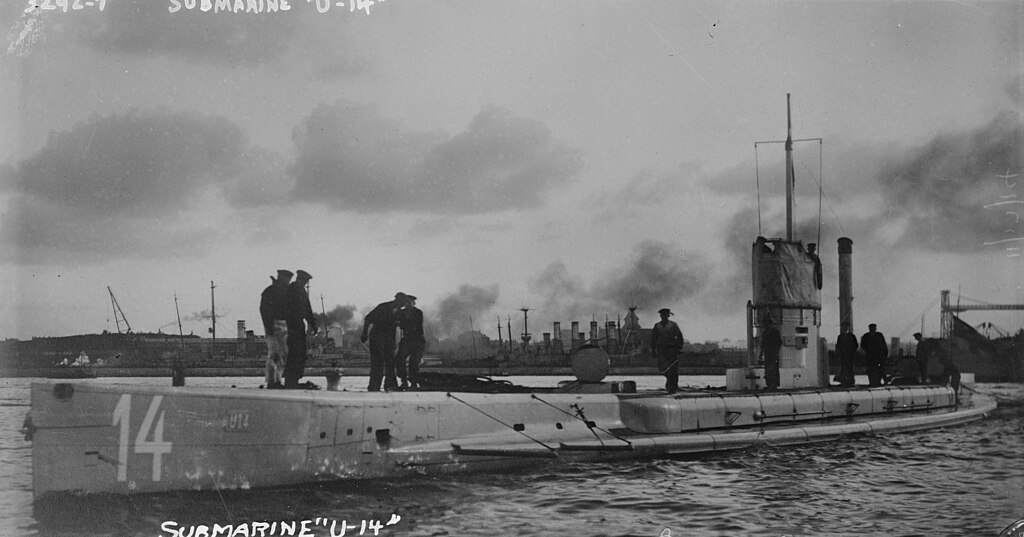
Design of the U13 class:
Hull and general design
The U13 was an incremental step, still considered as semi-experimental in the construction approach by the Navy top brass, especially Hipper. The U13 were barely longer versions of the U9 by a different yard, using the very same sections and conning tower, same armament and same crew, almost all the way back to U2. They repeated the same design with a clearly separate upper outer hull with a flat deck running all along, straight prow, and large ballast tanks below surrounding the cylindrical pressure hull. The top of these ballast tanks was flat, so that in port, the crew could step on it for close manoeuvres. This was also believed to improved stability in rough weather.
They were 57.88 m long, 6 m wide, with a draught of 3.44 m, for a displacement of 516 tons when surfaced, 644 tons when submerged.
The crew comprised 29 men, with four officers.

Above, a “family portait” with U13, the lead boat, to the left, directly next to the sub tender SM Acheron.
Powerplant
This was an interesting evolution of previous designs, with the same goal since 1910, to reach a critical surfaced speed enabling them some range for manoeuvres to attack or escape. At no point they were expected to follow the fleet (battle speed was 21 knots) but rather gain an ambushing position. The engines for surface travel comprised not two but four engines:
Two Körting six-cylinder 2-stroke petroleum (gasoline) engines,
Two Körting 8-cylinder 2-stroke Parrafin engines,
Total output was 882 kW (1,200 hp) for 900 PS (660 kW; 890 shp) at 550 rpm.
Underwater they were powered by two SSW Doppel-Modyn-Elektromotor electric motors rated for 860 kW (1,160 hp) or 1,040 PS (760 kW; 1,030 shp) total (depending on sources) at 600 rpm.
These enabled speeds of 14.8 knots when surfaced (27.4 km/h; 17.0 mph) and 10.7 knots underwater (19.8 km/h; 12.3 mph), quite an impressive feat as all previous U-Boats were capable of 13 knots at best, and 8 knots underwater.
Their operating radius was up to 4,000 nm (7408 km) when surfaced. When submerged at 5 knots, they still can reach 90 NM (167 km).
Bu more importantly, they could go under a maximum diving depth of 50 meters (150 ft), versus 30 meters (90 ft) for the previous U9 class boats.
At this point it might be interesting to note these successful boats, again, were not powered by diesels when surfaced. For this, we will have to wait for 1910, when this proposal was floated out by no less than the same yard in Dantzig: The U19 class. In between Germaniawerft delivered U16 (see below) and Dantzig made a follow-up of its U13 class with the U17 class (U17, U18).
The major difference was that for the U17 class, the same four kerosene powered plants were used instead of mixing kerosene and parrafin engines, as the former were compared and judged superior.
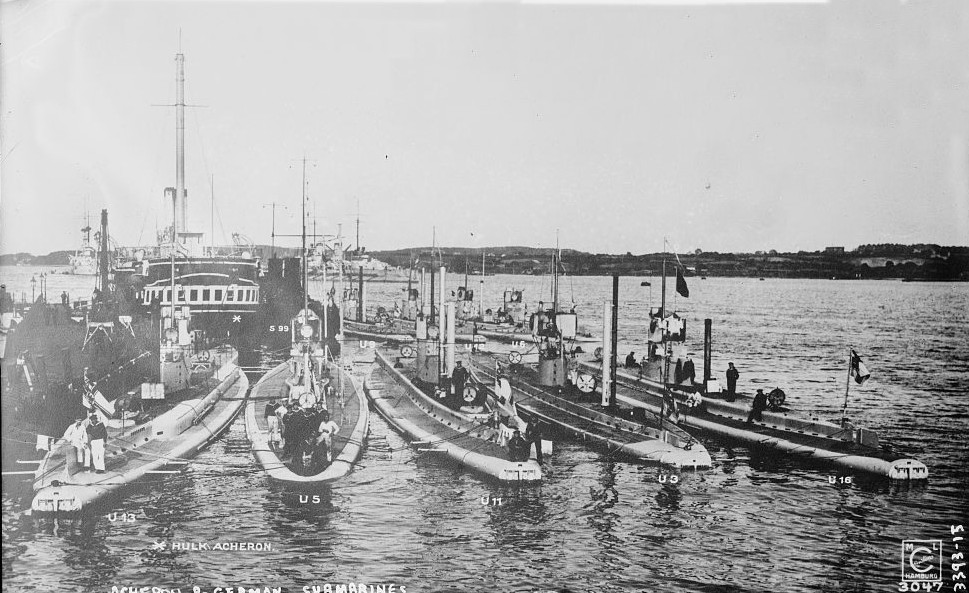
Armament
The U13 were armed exactly like previous U9 boats, with six torpedoes carried internally, two bow and two stern tubes.
Torpedo Tubes
The four 450 mm (17.7 inches) torpedo tubes could be reloaded from above via the larger hatches described above, and these were the 45 cm (17.7″) C/06 of 1907, 1,704 lbs. (773 kg) for 222 in (5.650 m) in lenght, carrying a warhead of 270 lbs. (122.6 kg) TNT to 1,640 yards (1,500 m) at 34.5 knots or 3,380 yards (3,000 m) at 26 knots due to her Brotherhood system. More on navweaps
3.7cm/27 L/30 Hotchkiss Gun
Originally these boats were likely armed with a 7.9mm/79 Maxim machine gun installed on a pintle aft of the CT until 1914.
The new Hotchkiss L/30 was installed by late 1914.
It was manufactured under licence by the Gruson company, named ‘3.7 cm Revolver Kanone Hotchkiss – Gruson’.
Weight 571 kg, 32.20mm (total tube length), 20 rifled part, 12x grooves 6 degrees angle
Projectile weight: 0.63 kg HE or 0.64 kg shrapnel, mv 494 m/s
Fire rate 32-50 rpm, range 2000 m HE, +18 degrees elevation.
5cm/37 SK L/40 C/92 Gun
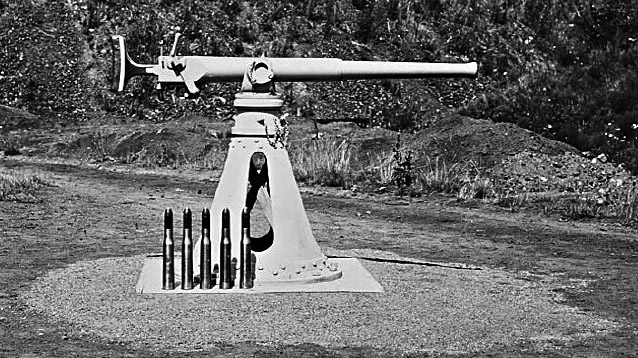
Installed on U9 to U12 from 1915.
Designed in 1892 but produced as the 5 cm SK L/40 (2 inches) first and replaced by the 5 cm Tbts KL/40 in 1913.
It weighted 240 kg (530 lb), for 2 m (6 ft 7 in) long, 1.83 m (6 ft) barrel.
It fired a Fixed QF 52 x 333R 1.75 kg (3.9 lb) HE shell at 656 m/s (2,150 ft/s)
The Breech was of the Horizontal sliding-wedge type for a rate of fire of 10 rpm
Elevation was -5° to +20°, traverse 360° with a single gunner, and two loaders.
Maximum firing range was 6.2 km (3.9 mi) at +20°. This was considered a defensive gun only, as the round had little power.
10.5 cm SK L/45 naval gun
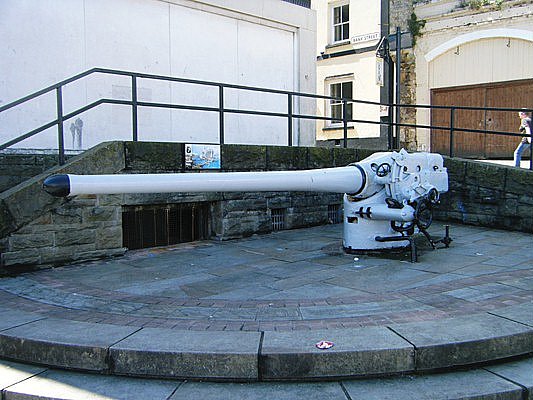
In 1915 they received a 105mm deck gun with 300 rounds. For this, the crew rose to 35 men, still with four officers, albeit one was now a gunnery officer.
Built by Meddinghaus it was designed specially for deck use, low, with many sensible elements protected from corrosion.
Specs:
1,450 kg (3,200 lb), 4.725 m (15 ft 6.0 in), 6.8 mm (0.27 in) wide.
Shell 10.5 cm (4.1 in) 25.5 kg (56 lb) fixed Brass Casing 17.4 kg (38 lb)
Breech: Horizontal sliding-block, MPL C/06: -10° to +30° mount
Rate of fire: 15 RPM
Muzzle velocity 710 m/s (2,300 ft/s)
Effective range 12,700 m (41,700 ft) at 30°
Author’s rendition
⚙ U13 class specifications |
|
| Displacement | 516 t (508 long tons) surfaced, 644 t (634 long tons) submerged |
| Dimensions | 57.88 x 6 x 3.44m (189 ft 11 in x 19 ft 8 in x 11 ft 3 in) |
| Propulsion | 2 shafts Körting 6-cyl. kerosene +2x 8-cyl. Parrafin 900 PS, 2× EM 1,040 shp |
| Speed | 14.8 knots (27.4 km/h) surfaced, 10.7 knots (19.8 km/h) submerged |
| Range | 2,000 nmi/14 kts/90 nmi at 3 kts, 64t oil |
| Armament | 4× TTs (2 bow, 2 stern), 6x 45 cm (18 in) torpedoes, 3.7 cm (2 in) SK L/40 gun (1914) |
| Max depth | 50 m (160 ft) |
| Crew | 4 officers + 25 men peacetime |
The case of U16
U16 was a comparative boat ordered by the Kaiserliches Marine from Germaniawerft. She was given the same specifications and that was for comparative tests. However she ended smaller and faster while surfaced as a result. Unlike the U13 class boats, she was very successul in her career too. She was “double-hulled” and ocean-going, but designed by Hans Techel. U16 was launched on August 29, 1911 at the Germania shipyard in Kiel, commissioned on December 28, 1911 under Lieutenant Commander Paul Clarenbach.
She was slighlty shorter than the U13 at 57.8 m long, for the same beam, and similar draft of 3.36 m (3.4 in many publications) for a lower displacement surfaced of 489 tons, 627 tons underwater. The crew was the same at 29 men, and she had almost the same powerplant, two 6-cyl. (550 rpm) and two 8-cyl. (600 rpm) all paraffin (Gasoline) Körting engines for 1,200 hp and two SSW twin Modyn electric motors for 860 hp. The result was a better speed at 15.6 knots surfaced and the same 10.7 knots underwater, and much better range on paper at 4,500 nautical miles surfaced, 90 underwater, same diving depth of 50 meters, same armament consisted of two bow, two stern tubes, 6 in all, and a 37 mm revolver cannon replaced by a 5 cm gun in 1915.
Here are her specs below:
⚙ U16 specifications |
|
| Displacement | 489 t (481 long tons) surfaced, 627 t (617 long tons) submerged |
| Dimensions | Same but 57.88m (189 ft 8 in) oa. |
| Propulsion | 2 shafts, 2x Körting 6-cyl. 2x 8-cyl. Gasoline 1200 hp, 2× EM 860 shp |
| Speed | 15.6 knots (27.4 km/h) surfaced |
| Range | 2,100 nm at 15 kts, 4,500 nm at 5 kts |
| Armament | 4× TTs (2 bow, 2 stern), 6x 45 cm (18 in) torpedoes, 3.7 cm (2 in) SK L/40 gun (1914) |
| Max depth | 50 m (160 ft) |
| Crew | 4 officers + 25 men peacetime |
U17 class
Dantzig Naval Yard saw the possibilities to upgrade its U13 design, notably seeing what Germaniawerft made of the U16. The core idea was to simplify engineering mechanics work and maintenance by having a simplified set of four parraffin engines all identical rather of a mix of 6-yclindre and 8-cylinder models using parraffin or kerosone. There were already talks of using the recently developed engine by Prof. Rudolf Diesel on board, but the latter still had initial issues, the yard decided to wait for a later class to implement them. Instead, the new U-17 class would have a conventional powerplant but a better range of possible.
To house four identical, larger engines it was decided to slightly increase the hull in lenght and beam. Thus, the displacement standard wetn from 516 to 564t, overall lenght from 57.88 meters to 62.35 meters, which was quite substantial. The beam stayed the same, and the draught stayed about the same as well around 3.44m. The conning tower was also the same model as well as the location of the hatches and general outlook. The armament was unchanged as well, with a 7.9mm/79 machine gun for AA defense, so the extra internal space somethwat improved conditions for the same crea as before of 29 men overall, including officers.
The engineering part was of course the most interesting, as to run surfaced, U17 and U18 used four identical eight-cylinder two-stroke Körting petrol engines, with a total output of 1,030 kW (1,400 hp). Underwater, they were procured two AEG twin Modyn electric motors with a total output of 824 kW (1,120 hp. Top speed while surfaced was less than expected however, compared to U16, at 14.9 knots and down to 9.5 knots submerged, also less than U13 class. However their operating radius was greater, and they carried ten tons more (74 vs. 64t fuel oil) thanks to the extra lenght, making for greater tanks, at 6,700 Nautical Miles surfaced, versus 2,000-2,100, albeit at 8 knots*. When submerged at 5 knots, they were capable of 75 nautical miles. The diving depth was unchanged at 50 meters but agility was lower due to the greater lenght-to-width ratio. It seems counter-intuitive they ended slower given the greater lenght-to-beam ration and extra power, but here it was. U17 (U18 sank before) was upgraded in 1915, receiving a second 5 cm gun. Overall, apart for the career of U17, the class was a disappointment, further urging the need to transition to the diesel-powered U19.
*Wikipedia seems to point out 6700 nm at 15 kts, but it’s infirmed by Conways, clearly an error.
⚙ U17 class specs. |
|
| Displacement | 564 t surfaced, 691 t submerged |
| Dimensions | 62.35 x 6 x 3.40m (204 ft 7 in x 19 ft 8 in x 11 ft 2 in) |
| Height | 7.30 m (23 ft 11 in) |
| Propulsion | 2 shafts, 2×2 8-cyl. Parrafin 1400 PS, 2× AEG EM 1,120 shp |
| Speed | 14.9 knots (27.6 km/h) surfaced, 9.5 knots (17.6 km/h) submerged |
| Range | 6,700 nmi/8 kts/75 nmi at 5 kts, 74t oil |
| Armament | 4× 45cm TTs (2 bow, 2 stern, 6 torpedoes), 3.7 cm (2 in) SK L/40 gun (1914) |
| Max depth | 50 m (160 ft) |
| Crew | 4 officers + 25 men peacetime |
Career of the U13 class
 U13
U13

U13 was Ordered on 23 February 1908 to Kaiserliche Werft Danzig for 2,101,070 Goldmark at Yard 8, laid down the same year, launched on 16 December 1911, commissioned on 25 April 1912 and she conducted a in single patrol. She had been under Lieutenant Commander Richard Pohle from 25 April 1912 to 1st August 1914, then replaced in wartime by Lieutenant Commander Hans Artur Graf von Schweinitz. On August 6, 1914, she left the Heligoland naval base for a first patrol with nine other submarines. She was to form a sentry line with intervalled over seven nautical miles. According to orders she was not to cross the 59th parallel. On August 9, 1914, she was reported missing. It was assumed sank without on August 12, three days after U 15. All 29 crew members, including the commanders Graf von Schweinitz and Krain Freiherr von Kauder went down with her. The exact cause remained unclear and her wreck was never rediscovered. She probably struck a mine or sank as a result of an accident as no British reoported having sunk a submarine in the area at the time.
 U14
U14
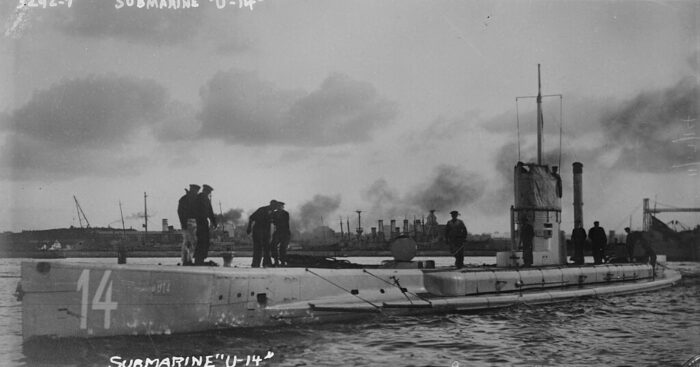
The double-hulled ocean-going U-14 was ordered on February 23, 1909, laid down at the Imperial Shipyard in Danzig on July 11, 1911, completed on April 24, 1912, and commissioned on April 25, 1912, under command of Lieutenant Walther Schwieger. Her was succeeded by Walther Schwieger from 1 August 1914 to 15 December, then Otto Dröscher until 15 April 1915 and Max Hammerle until her loss on 5 June 1915. She conducted nine patrols (no sinkings, but conflicted sources). One stated on her first patrol she sank the 1,669 GRT Danish freighter Cyrus on 2 June 1915 and a day later, the Swedish freighter Lappland (2,238 GRT) bewteen Narvik and Middlesbrough. On 5 June 1915,she was surfaced wjen caught by the RN armed trawler Oceanic II, off the Scottish coast east of Aberdeen (in fog). Unsure of what she was, Captain Hammerle fired a warning shot to challenge her. Oceanic II answered by immediately opened fire. Hammerle immediately ordered to dive, but due to a damaged flood valve, only the stern went down, the bow remained above water, pummeled. Meanwhile, more armed trawlers arrived and fired at her bow, closing range until Hammerle had no mor option but to surface and surrender. Before he can do so however U-14 was rammed by the trawler Hawk. Badly damaged, he still surfaced and gave the order to abandon ship, sinking rapidly. 27 crew members were rescued but the commander remained on board.
 U15
U15
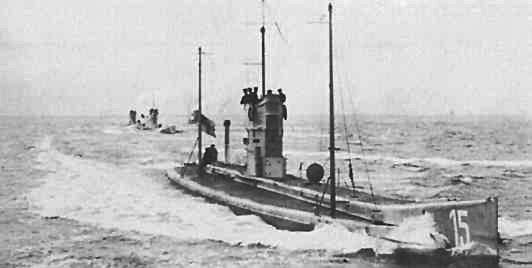
U15 was launched on September 18, 1911 and commissioned on July 7, 1912. She conducted only two patrols and sank no ship. Her first captain until the war was Lieutenant Hans Adam from 7 July 1912 and Richard Pohle 1 August 1914 until her loss. Five days after he took command U-15 and nine other U-boats left Heligoland for Britain and on August 8, she spotted the modern dreadnought of the Orion class HMS Ajax, Monarch, and Orion. She lunched her torpedoes but missed HMS Monarch. This was the first submarine combat action by a German U-boat in this war. The next morning, U-15 was surfaced while in fog when the light cruiser HMS Birmingham emerged from it near Fair Isle. CaptainPohle immediately ordered to submerged, but something broke done and before she could do so, she was rammed by the cruiser. She was rolled completely over and broke in two due to the pressure, sinking with all hands as the first U-boat lost in World War I.
 U16
U16
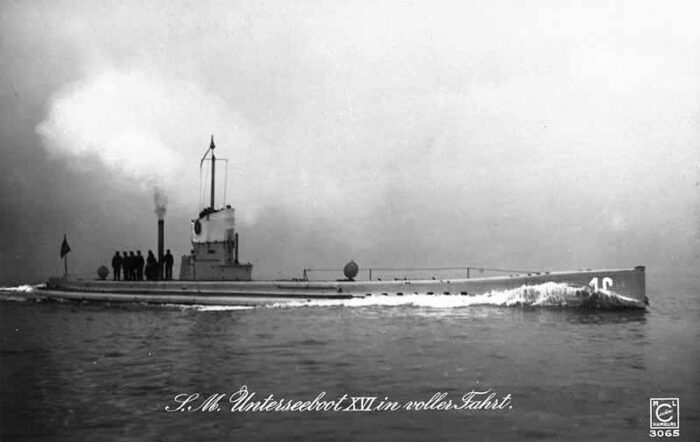
U16 was ordered on 26 August 1909 to Germaniawerft, Kiel on the same design, at a Cost of 2,539,000 Goldmark in yard 157. Laid down on 10 May 1910 she was launched on 29 August 1911 and commissioned on 28 December 1911. Before the war she was under command of KtLt Paul Clarenbach until 31 July 1914. She started her career with Kapitänleutnant Klaus Hansen from 1. August to 15. March 1915, then Oberleutnant zur See Leo Hillebrand until 21 October 1915, Kapitänleutnant Kurt Hartwig until June 1916, Friedrich Crüsemann, August Mildenberger, Karl Meusel from December 1916 until February 1917, Karl Edeling, Herbold Rabe von Pappenheim, Wilhelm Canaris (yes, this one) from 2 June 1917 to 11 September 1917, Heinrich Middendorff, Edmund Pauli, Karl-Friedrich von Abendroth, Paul Stratmann, Gerhard Behn and Erich Metzenthin in November 1918. She made thus 13 patrols, sinking ten Entente merchant ships for 11,476 GRT. Other sources mention only four combat patrols, eleven ships and 11,730 GRT but 11,228 GRT damaged, one captured at 838 GRT. She survived the War.
Her successes were the British Dulwich (3,289 GRT), French Ville de Lille (997t) Dinorah (4,208 GRT, Damaged), Norwegian Belridge (7,020t, Damaged), Swedish M. Roosval (309t), Danish Betty (2,109 GRT), Russian Mars (251t), Danish Søborg (2,108 GRT), Thorvaldsen (1,220 GRT), Ellen Benzon (143 GRT) and Norwegian Flora (184 GRT), Actie (562 GRT), Florida (558 GRT), the Swedish Pallas (838 GRT) being captured as prize. All in February, May and September 1915 under Klaus Hansen and Leo Hillebrand. On 8 February 1919, she was attributed by the allied commission as war repartriation to Britain but sank while under tow during her delivery voyage to Britain in the North Sea.
Career of the U17 class
SM U-17, which sank the first British merchant vessel in the First World War (and ten more ships, damaged one, captured two ships) as the lead ship of a small class of two boats with U-18, both built at Dantzig Nyd. and incrementally improved on the previous Dantzig Boats, namely the U13 class. Her sister ship, U18 was a unique case of a submarine sunk by coastal artillery, while approaching Scapa Flow in November 1914. Next stop: Dantzig’s first diesels subs, the U19 class.
 U17
U17
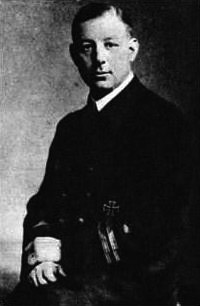 U17 was laid down at Dantzig NyD Yard 11 on 1 October 1910, Launched on 16 April 1912 and commissioned on 3 November 1912 at a cost of 2,333,000 Goldmark. She trained in 1913 under Kapitänleutnant Johannes Feldkirchner until 7 March 1915. At the start of the war she operated with the 1st U-boat Flotilla in Kiel. KpLt. Hans Walther took command until 26 December, then
U17 was laid down at Dantzig NyD Yard 11 on 1 October 1910, Launched on 16 April 1912 and commissioned on 3 November 1912 at a cost of 2,333,000 Goldmark. She trained in 1913 under Kapitänleutnant Johannes Feldkirchner until 7 March 1915. At the start of the war she operated with the 1st U-boat Flotilla in Kiel. KpLt. Hans Walther took command until 26 December, then
Hermann von Fischel and from January 10, 1916, and until the end of the war, she was used for training. However she also performed sixteen successful patrols in 1915, during which she sank twelve merchant ships for a total tonnage of 16,635 GRT. According to other sources, she performed four patrols, claimed eleven ships sunk, two captured as prizes, forh a total tonnage of 4,956 GRT.
The first successful attack was on the English steamer Glitra (866 GRT) on October 20, 1914, first sinking of a merchant ship in the First World War, but following th rules. Six days later on October 26 she torpedoed the 4,590-ton French cross-Channel ferry Amiral Ganteaume near Cap Gris-Nez, killing 40, as the first unwarned attack by a German submarine on a merchant ship.
Next she sank the following ships, all verified postwar: On June 12, 1915, the British tanker Desabla (6,047 GRT), on August 8, 1915, the Swedish steamer Malmland (3,676 GRT), on the 10th the British steamer Utopia (155 GRT), on the 14th, the British fishing trawler Gloria (130 GRT), on the 16th the Norwegian steamer Romulus (819 GRT) and Norwegian steamer Tello (1,218 GRT) the same day.
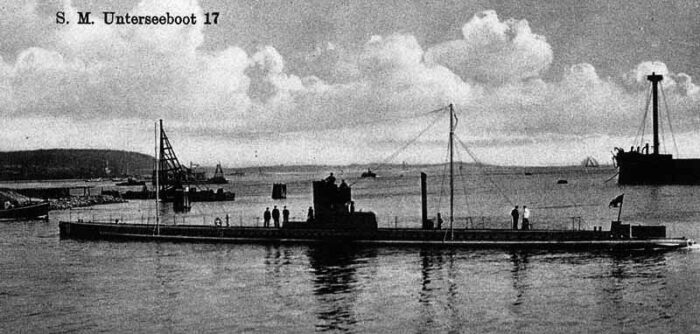
After 1916, she had several captains, Kapitänleutnant Johannes Feldkirchner until 23 April 1916, Walter Remy until 3 October, Karl Koopmann until 15 January 1917, Max Eltester until 12 March, Kurt Heeseler until 15 May, Walther Telge until 28. July, Hans Beyersdorff until 14 December and Corvettekapitan Paul Pastuszyk untol 20 July 1918. Nor record for the next captain, she was likely placed in reserve. On January 27, 1919, she was stricken and scrapped at the Kaiserliche Werft in Kiel. The wreck was then was sold to Stinnes AG in early 1920.
 U18
U18
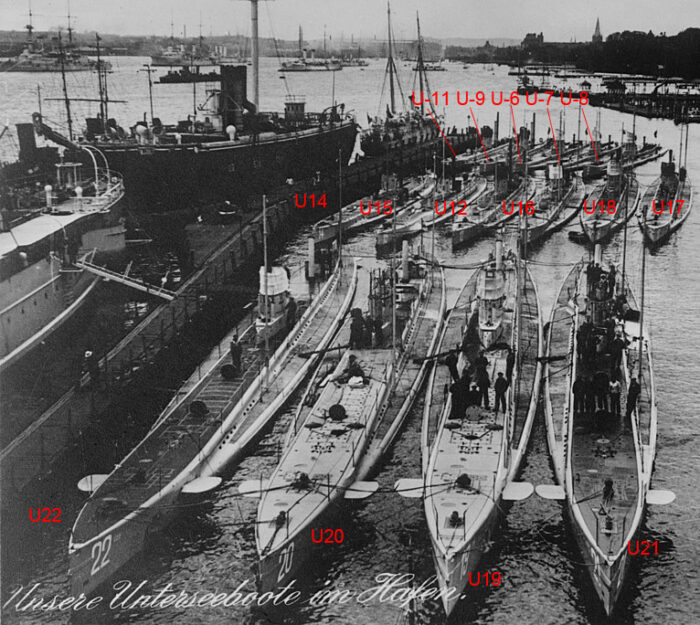
U18 was ordered on May 6, 1910 at Kaiserliche Werft Danzig for 2,333,000 Goldmark like her sister, in Yard 12 from 27 October 1910. She was launched on 25 April 1912 and commissioned on 17 November 1912. Her captain before the war is not known. On the was start, whe was under command of Kptlt. Heinrich von Hennig under her loss. U-18 set sail on August 6, 1914, at 4:30 a.m., with nine other submarine for the first patrol in World War I. On September 13, she rescued part of the crew of the light cruiser Hela, torpedoed southwest of Heligoland by the British submarine E9.
On November 23, 1914, she penetrated Hoxa Sound, main southern entrance into Scapa Flow (Orkney Islands). An exploit that was repeated in WW2 by U-47. However even at this stage, the threay of German U-Boat incursion was tekn seriously and captain von Hennig had overcome nets and barriers. The British indeed had elready evacuated the base by that time, so U-18 after all its effort, found no worthwhile target. While attempting to withdraw, she was first spotted by the armed trawler “Tokio” and shortly afterwards, rammed by the armed minesweeper”Dorothy Grey” in the Pentland Firth, while U18 was still at periscope depth, unable to completely submerged in these shallow waters. Both periscopes werebend, her diving planes damaged and jammed, making a controlled dive impossible. Notified, the destroyer HMS Garry rushed to the scene and giving her dreater draught, also rammed U18, expecting greater damage. Indeed, the U-Boat was forced down uncontrollably down to 70 m, but by blasting the ballasts, her captain decided it was important to save the crew at this point and she managed to resurface. Hennig ordered the boat to be scuttled while crew evacuated on good order with a white flagn, except for one sailor, which managed to escape and was later taken prisoner, following 22 others. A single sailor died aboard.
Read More/Src
Books
Johannes Spieß: Sechs Jahre U-Bootfahrten. R. Hobbing, Berlin 1925.
Johannes Spieß: U-Boot-Abenteuer. 6 Jahre U-Boot-Fahrten. Verlag Tradition Kolk, Berlin 1932 Kriegsabenteuer eines U-Boot-Offiziers. Berlin 1938.
Bodo Herzog, Günter Schomaekers: Ritter der Tiefe, graue Wölfe. Die erfolgreichsten U-Bootkommandanten der Welt. 2.
Gröner, Erich; Jung, Dieter; Maass, Martin (1991). U-boats and Mine Warfare Vessels. German Warships 1815–1945. Vol. 2. Conway Maritime Press.
Rössler, Eberhard (1985). The German Submarines and Their Shipyards: Submarine Construction Until the End of the First World War. Bernard & Graefe.
Werner von Langsdorff: U-Boote am Feind. 45 deutsche U-Boot-Fahrer erzählen. Bertelsmann, Gütersloh 1937.
Carl Ludwig Panknin: Unterseeboot „U. 3“. Verlagshaus für Volksliteratur und Kunst, Berlin 1911
Unterseeboot „U. 9“. Schiffe Menschen Schicksale.
Bodo Herzog: Deutsche U-Boote 1906–1966. Erlangen: Karl Müller Verlag, 1993
Eberhard Möller/Werner Brack: Enzyklopädie deutscher U-Boote Von 1904 bis zur Gegenwart, Motorbuch Verlag, Stuttgart 2002
Ulf Kaack: Die deutschen U-Boote Die komplette Geschichte, GeraMond Verlag GmbH, München 2020
Robert Hutchinson: Kampf unter Wasser – Unterseeboote von 1776 bis heute, Motorbuch Verlag, Stuttgart 2006
Links
en.wikipedia.org SM_U-9
uboat.net/ types U13
uboat.net U16
uboat.net/ u18
navypedia.org u17






 Latest Facebook Entry -
Latest Facebook Entry -  X(Tweeter) Naval Encyclopedia's deck archive
X(Tweeter) Naval Encyclopedia's deck archive Instagram (@navalencyc)
Instagram (@navalencyc)





 French Navy
French Navy Royal Navy
Royal Navy Russian Navy
Russian Navy Armada Espanola
Armada Espanola Austrian Navy
Austrian Navy K.u.K. Kriegsmarine
K.u.K. Kriegsmarine Dansk Marine
Dansk Marine Nautiko Hellenon
Nautiko Hellenon Koninklije Marine 1870
Koninklije Marine 1870 Marinha do Brasil
Marinha do Brasil Osmanlı Donanması
Osmanlı Donanması Marina Do Peru
Marina Do Peru Marinha do Portugal
Marinha do Portugal Regia Marina 1870
Regia Marina 1870 Nihhon Kaigun 1870
Nihhon Kaigun 1870 Preußische Marine 1870
Preußische Marine 1870 Russkiy Flot 1870
Russkiy Flot 1870 Svenska marinen
Svenska marinen Søværnet
Søværnet Union Navy
Union Navy Confederate Navy
Confederate Navy Armada de Argentina
Armada de Argentina Imperial Chinese Navy
Imperial Chinese Navy Marinha do Portugal
Marinha do Portugal Mexico
Mexico Kaiserliche Marine
Kaiserliche Marine 1898 US Navy
1898 US Navy Sovietskiy Flot
Sovietskiy Flot Royal Canadian Navy
Royal Canadian Navy Royal Australian Navy
Royal Australian Navy RNZN Fleet
RNZN Fleet Chinese Navy 1937
Chinese Navy 1937 Kriegsmarine
Kriegsmarine Chilean Navy
Chilean Navy Danish Navy
Danish Navy Finnish Navy
Finnish Navy Hellenic Navy
Hellenic Navy Polish Navy
Polish Navy Romanian Navy
Romanian Navy Turkish Navy
Turkish Navy Royal Yugoslav Navy
Royal Yugoslav Navy Royal Thai Navy
Royal Thai Navy Minor Navies
Minor Navies Albania
Albania Austria
Austria Belgium
Belgium Columbia
Columbia Costa Rica
Costa Rica Cuba
Cuba Czechoslovakia
Czechoslovakia Dominican Republic
Dominican Republic Haiti
Haiti Hungary
Hungary Honduras
Honduras Estonia
Estonia Iceland
Iceland Eire
Eire Equador
Equador Iran
Iran Iraq
Iraq Latvia
Latvia Liberia
Liberia Lithuania
Lithuania Mandchukuo
Mandchukuo Morocco
Morocco Nicaragua
Nicaragua Persia
Persia San Salvador
San Salvador Sarawak
Sarawak Uruguay
Uruguay Venezuela
Venezuela Zanzibar
Zanzibar Warsaw Pact Navies
Warsaw Pact Navies Bulgaria
Bulgaria Hungary
Hungary

 Bundesmarine
Bundesmarine Dutch Navy
Dutch Navy Hellenic Navy
Hellenic Navy Marina Militare
Marina Militare Yugoslav Navy
Yugoslav Navy Chinese Navy
Chinese Navy Indian Navy
Indian Navy Indonesian Navy
Indonesian Navy JMSDF
JMSDF North Korean Navy
North Korean Navy Pakistani Navy
Pakistani Navy Philippines Navy
Philippines Navy ROKN
ROKN Rep. of Singapore Navy
Rep. of Singapore Navy Taiwanese Navy
Taiwanese Navy IDF Navy
IDF Navy Saudi Navy
Saudi Navy Royal New Zealand Navy
Royal New Zealand Navy Egyptian Navy
Egyptian Navy South African Navy
South African Navy






























 Ukrainian Navy
Ukrainian Navy dbodesign
dbodesign